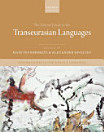The Oxford Handbook of Archaeology and Language
Martine Robbeets · Mark Hudson
Sep 2025 · Oxford University Press
Ebook
1008
Pages
family_home
Eligible
info
reportRatings and reviews aren’t verified Learn More
About this ebook
This volume provides a comprehensive and up-to-date overview of how archaeology, genes, and language can be combined to shed light on the human past. Our understanding of human prehistory has been revolutionized in recent years by the growth of interdisciplinary perspectives, and particularly by insights from the study of ancient DNA. At a time when the 'Big Data' movement in genetics and archaeology is beginning to make inroads into linguistics, The Oxford Handbook of Archaeology and Language sets the agenda for future research in the discipline of archaeolinguistics. The handbook is divided into three parts. The first part introduces the basic frameworks of archaeolinguistics, addressing recent trends and new perspectives. Chapters in Part II explore the application of archaeolinguistics to different stages in human history, from hunter-gathering via the adoption of farming and the rise of writing to modern times. Part III features regional case studies from different parts of the world, including not only Indo-European but also Uralic, Transeurasian, Sino-Tibetan, Paleosiberian, Tai-Kadai, Austronesian, Papuan, Australian, Afrasian, Nilo-Saharan, Niger-Congo, Kalahari Basin, Andean, and Lowland South American languages. In illustrating the extent to which linguistic, archaeological, and genetic histories align or differ, the volume goes beyond the level of 'broad brush' approaches by engaging specialists from a range of disciplines as co-authors, shedding light on language dynamics from multiple perspectives.
About the author
Martine Robbeets is Head of the Language and the Anthropocene Research Group at the Max Planck Institute of Geoanthropology in Jena and Honorary Professor in the Department of General and Comparative Linguistics at Johannes Gutenberg University, Mainz. She holds a PhD in Comparative Linguistics from the University of Leiden and a Habilitation in Linguistic Typology from the University of Mainz, and recently completed an interdisciplinary project on the dispersal of the Transeurasian languages, funded by an ERC Consolidator Grant. Her many publications include Diachrony of Verb Morphology: Japanese and the Transeurasian Languages (De Gruyter, 2015) and, co-edited with Alexander Savelyev, The Oxford Guide to the Transeurasian Languages (OUP, 2020). Mark Hudson is Researcher at the Language and the Anthropocene Research Group at the Max Planck Institute of Geoanthropology in Jena. He was educated at SOAS University of London, Cambridge University, and the Australian National University, and is a Fellow of the Royal Historical Society. His recent publications include Conjuring Up Prehistory: Landscape and the Archaic in Japanese Nationalism (Archaeopress, 2021) and Bronze Age Maritime and Warrior Dynamics in Island East Asia (Cambridge University Press, 2022).
Rate this ebook
Tell us what you think.
Reading information
Smartphones and tablets
Install the Google Play Books app for Android and iPad/iPhone. It syncs automatically with your account and allows you to read online or offline wherever you are.
Laptops and computers
You can listen to audiobooks purchased on Google Play using your computer's web browser.
eReaders and other devices
To read on e-ink devices like Kobo eReaders, you'll need to download a file and transfer it to your device. Follow the detailed Help Center instructions to transfer the files to supported eReaders.







